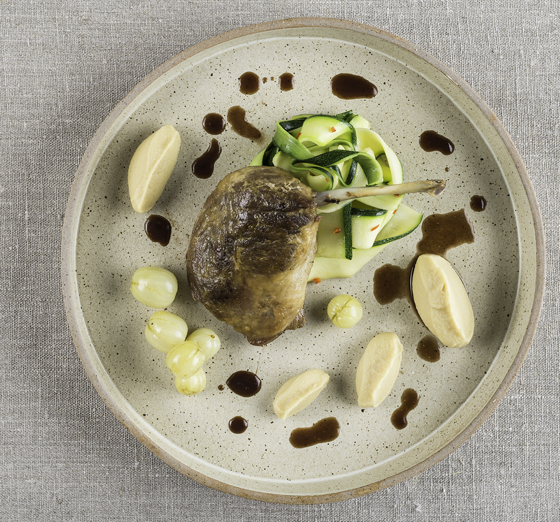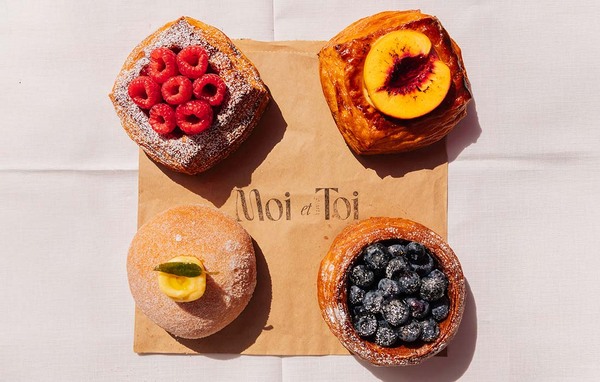Home-grown harvest: sweet and savoury ways with gooseberries
Pucker up, it's gooseberry season. Russell Brown has a sweet and a savoury option for this scarce yet flavourful fruit
There are only a handful of commercial gooseberry growers in the UK with a total annual production of around 200 tonnes, which is a dramatic decline in the fortunes of a berry that has been cultivated for centuries.
The downturn in the popularity of the gooseberry seems to be due to the growing success of other summer berries. Crops such as strawberries and blueberries have seen much greater investment and subsequently much greater take up by the buying public. Add to this a relatively short season and berries that, when ripe, are fairly delicate, and it is easy to see why the gooseberry has suffered.
The berries, when ripe, can be seen in green, white, yellow and red variations and as they ripen they become softer and sweeter, but are still generally tart. The dessert gooseberry is much sweeter and can be eaten raw â" the difference is similar to that of eating apples and cooking apples. The season runs from May to August with a peak in June and July.
The sharp tang of the green gooseberry is the way most of us think of the fruit, and they either need plenty of sugar for use in desserts or can be used in savoury recipes. The classics are mackerel with gooseberry sauce or gooseberry fool, and jams, jellies, chutneys and pickles are also common. The berries can be poached, stewed, puréed or baked in pies and crumbles.
A number of chefs have expressed a real love for gooseberries and many are growing their own fruit. Nathan Outlaw has a dish on his menu of cured monkfish with gooseberry and lemon, and a recipe for elderflower custard tart with poached gooseberries features in his latest book, Nathan Outlawâs Home Kitchen.
Chef Philip Verden at the Lord Poulett Arms in Hinton St George, Somerset, is serving local gooseberries with a Pomona (a type of apple brandy) syllabub, while Paul OâNeill, head chef at Berwick Lodge in Bristol, has a gooseberry and elderflower trifle on the afternoon tea menu. Richard Mann, head chef at Camellia at South Lodge near Horsham, in West Sussex, is serving a sorbet and sliced berries with mackerel. And Melissa Cole, author and beer journalist, suggests letting down a compôte with a peppery saison and finishing the sauce with sorrel to serve with mackerel.
Market report
The UK gooseberry season is relatively short, usually just June until late August. Green gooseberries appear first, with the red varieties following a couple of weeks later. Expect to pay £3-£4 per kilo for green gooseberries and twice that for the red varieties.
Charlie Hicks
totalproducelocal.co.uk
Buying and storage
The keeping qualities of gooseberries vary according to how ripe the fruit is: underripe, firm fruit will keep in the fridge for one to two weeks, whereas ripe dessert fruit will only keep for a few days. Choose the type and ripeness of fruit according to the dish requirements and choose firm, dry berries that are rich in colour.
Crispy duck leg with pickled gooseberries and spiced courgettes
Serves six
For the duck
6 trimmed duck legs
Coarse sea salt
2 cloves garlic, sliced
Zest of 1 orange
6 sprigs of thyme
Duck fat for cooking
For the gooseberries
200g firm gooseberries
100g caster sugar
100g white wine vinegar
100g white wine
1 lime, juice and zest
12 black peppercorns
1tsp mustard seeds
5g Maldon sea salt
For the chickpea purée
1 small banana shallot, diced
1 clove garlic, minced
100ml vegetable stock
250g cooked chickpeas
50ml light olive oil
Lemon juice (to taste)
Maldon sea salt and freshly ground black pepper
For the courgettes
Olive oil for frying
1 clove garlic, smashed
1 small red chilli, deseeded and diced
2 medium courgettes, cut into ribbons
Maldon sea salt and freshly ground black pepper
To serve
100ml duck jus
Begin by curing the duck legs. In a plastic tray that will hold the duck in one layer, sprinkle a layer of the coarse salt, then scatter over the garlic, orange zest and thyme. Press the duck legs flesh-side down into the salt and then sprinkle a thin layer of salt over the top. Cover with plastic wrap and refrigerate overnight. When you take the duck legs out next day, rinse and dry them on kitchen paper.
In a small roasting tray, melt enough duck fat to submerge the legs. Cook the duck in a low oven at 130ºC for approximately two hours until the meat is completely tender. If not using immediately, allow to cool in the fat and then refrigerate.
For the gooseberries, combine all of the ingredients except the berries in a small saucepan and bring to the simmer, stirring occasionally. Add the berries, bring back to a simmer and then remove from the heat. Allow to cool. Drain the berries, retaining the liquid, which can be reused. A little of the pickling liquid can be reduced to glaze the berries.
For the purée, sweat the shallot and garlic in a little oil with a pinch of salt until tender. Add the stock and chickpeas. Season lightly and simmer for 10 minutes until the liquid is reduced by a third. Transfer to a small blender and blitz until smooth. Add the oil and season with the salt, pepper and lemon.
Cook the courgettes just prior to serving. Heat a little oil and add the smashed garlic. Allow the garlic to turn golden brown and then discard. Add the chilli and cook for 30 seconds. Add the courgette ribbons, season and wilt slightly, turning constantly in the pan.
To serve, crisp the skin side of the duck in a dry pan. If the duck has been chilled, turn it skin-side up, add a little water or stock to the pan and heat through in a hot oven. Place the courgette ribbons in mounds on the plates and lean the duck against the courgette. Spoon some of the purée to one side and scatter some pickled gooseberries around. Drizzle over a little duck jus to finish.

Gooseberry and elderflower crème brûlée
Serves six
For the gooseberries
125g caster sugar
150g elderflower cordial
350g gooseberries
For the granita
125g reserved poaching syrup
100g water
For the brûlée
425g double cream
130g free-range egg yolk
100g poaching syrup from the gooseberries
To serve
6 shortbread biscuits
For the gooseberries, heat the sugar and cordial in a pan that will hold the berries in one layer. Stir while heating until the sugar has dissolved and the syrup is simmering. Add the gooseberries and cook gently for two to three minutes until they begin to soften. Drain, retaining the syrup, and chill the berries. Reserve 100g of the syrup for the brûlée and 125g for the granita.
Mix the syrup for the granita with the water and freeze until solid. Prior to serving, scrape the surface of the mix with a fork to form small crystals.
For the brûlée, place the cream in a heavy-based pan. Heat until just below the simmer. Whisk the egg yolks and poaching syrup in a heatproof bowl until the mix is pale and forms a trail. Whisk the hot cream into the yolk mix. Return the custard to a clean pan and cook over a moderate heat, stirring constantly, until the mix begins to thicken.
Pass through a fine sieve into a jug and pour into individual ramekins (or stainless steel rings that have been wrapped in cling film and then foil). Place in a roasting tin and transfer to the oven shelf. Carefully fill the tin with hot water to about two-thirds of the way up the moulds.
Cook at 130ºC for approximately eight minutes until the custard is just set. Test by gently tipping one of the moulds. Chill to firm completely.
To serve, dust the brûlées with a thick layer of icing sugar and caramelise with a blowtorch. Place on a plate with crumbled shortbread, the poached berries and some of the shaved granita.
Coming up…
Over the next few months I will be featuring cherries and aubergines in Home-Grown Harvest. Do let me know how you use these products on your menus and what your seasonal favourites are. Email recipes, dish suggestions and photographs to russell@creativeaboutcuisine.com



















